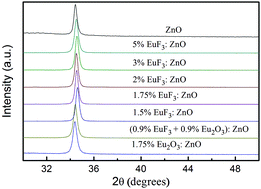Eu and F co-doped ZnO-based transparent electrodes for organic and quantum dot light-emitting diodes†
Abstract
A novel Eu and F co-doped zinc oxide (EFZO) thin film has been prepared by ion-assisted electron beam evaporation. The effects of different atomic contents of Eu and F on the structural, optical, and electrical properties of EFZO films were investigated. Eu3+ and F− ions are successfully incorporated into the ZnO lattice by the substitution of Zn2+ and O2− sites, respectively. Simultaneously, F− ions also play an important role of filling oxygen vacancy defects. Eu3+ and F− ions serve cooperatively as charge donor centers and compensate for the deformation in the ZnO crystal structure produced by either Eu or F individual ions, thus resulting in improving crystalline quality and electrical properties as compared with single element doping. Complementarity of Eu3+ and F− doping is assumed to be conducive to the F− filling oxygen vacancy effect in consideration of the changes in lattice constant and electrical parameters with varying dopant contents in EFZO films. An optimized EFZO film shows an average visible optical transmittance of 82.9% and a resistivity of 5.7 × 10−4 Ω cm corresponding to a carrier density of 1.86 × 1020 cm−3 and a mobility of 58.8 cm2 V−1 s−1. Conventional organic light-emitting diodes based on the EFZO anode and inverted structural quantum dot light-emitting diodes based on the EFZO cathode have been designed and fabricated, both of which show equivalent or a little higher electroluminescence performance in comparison to the reference ITO-based devices. Our results indicate that Eu and F are effective co-doping elements for ZnO transparent conducting oxide films, and EFZO transparent electrodes have efficient hole and electron injection abilities. As a promising candidate for low cost and high-performance transparent conducting oxide (TCO) films, EFZO can be used for a variety of optoelectronic devices.



 Please wait while we load your content...
Please wait while we load your content...